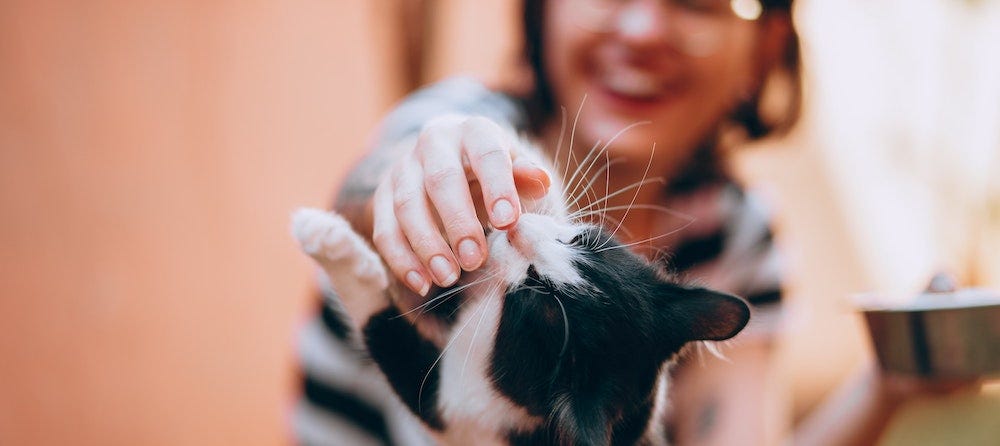1. The impulse to buy/adopt approach
Sure it’s difficult to pass by that furry little face looking at you with those innocent eyes (almost impossible if they sneak a “kiss”), but a spur of the moment decision to get a pet can spell disaster for both you and the pet. It’s always best to make sure you have an enthusiastic agreement with your spouse or other household members, a thumb’s up from your landlord or homeowner’s association, and the knowledge that Fido or Fluffy won’t send anyone at home into anaphylactic shock (i.e., no allergies here!). Skipping this step can lead to hard feelings, legal action, or even a trip to the emergency room–all of which almost guarantees a return trip to the shelter or pet store.
2. Underestimating the resources required to raise a pet
A pet can enrich a life like nothing else. Besides providing companionship and the fact that they are just plain fun, pets have been proven to lower stress levels, help alleviate grief, and give you a sense of purpose. They may be the only unconditional you will ever have.
With that said, you will want to be prepared to give as good as you get. And the cost of raising these little furry balls of joy? If you factor in adoption fees/purchase price, vaccines, vet bills, food, flea control, grooming tools, bedding, and miscellaneous supplies, expect to spend a low of $4,521 to a high of $18,322 to raise a cat to age 14 and from $4,242 to $38,905 for a dog, also to age 14.
3. Underestimating the time required to raise a pet
Both kittens and puppies need a lot of training and attention in order to thrive. Besides the weeks and sometimes months to train a dog not to mess in the house or knock grandma over or stop kitty from turning every wooden table into a whittling project, pets are prone to boredom just like people. Pets need to be kept mentally active and socially engaged. Bored pets are more apt to get into trouble and lonely pets can suffer from separation anxiety and destructive behaviors.
Plan on a lot of play and exercise time every day. If work keeps you away from home for long hours, consider adopting a companion for your pet. If two dogs are too much, think of the dog/cat combo. They don't always like to admit it, but many a dog will have a cat as a best pal.
4. Getting a pedigree cat or dog without doing the research
Many people have their heart set on a particular breed of cat or dog and if they have the money to spend, will make sure that dream comes true. While specific breeds of cats and dogs are sought after for a desirable look or personality trait, not knowing everything there is to know about the breed is a big mistake.
Since pedigrees are bred from a limited gene pool, the bad genes get passed along with the good. For instance, giant breeds such as the Great Dane and Rottweiler are at a higher risk of developing arthritis, join issues, and a variety of cardiac disease, while small er dogs are prone to dental disease, or in the case of the Daschund or Welsh Corgi, spinal issues. Cats like the long-haired Persian cannot keep its coat tangle-free without help, while hairless breeds like the Sphynx need bathing to deal with oily skin.
5. Not making your home pet friendly
Danger lurks with every blue watered toilet ball, tinseled Christmas tree, extension cord, tube of Gorilla Glue, window blinds, and that innocent looking houseplant. String, bottle tops and even that aforementioned underwear can be instruments of death.
Take the time to imagine things from your pet's perspective (yup, I'm talking about getting on all fours) and make sure you have the worst case scenarios covered. Never leave medication where a pet can get into it and remember that what the cat knocks off the counter, the dog will no doubt chew on (I'd like to believe the cat does not have ill intent toward the dog). Familiarize yourself with what is poisonous to your pet, including plants and food items, and make sure they are kept out of reach. Also make sure that any guests know which table scraps are off limits--including sneaking that juicy bone.
6. Failing to accept the fact that no matter what, there will be pee
Proper folk may swoon at the mention of such things, but it's best to get this out up front: at some point in time, something WILL be peed upon. And it will be the carpet rather than the easy-to-clean tile, or the new suede pumps instead of the tennis shoes you wear to take out the trash. With proper training, accidents should be few and far between, however, even the most well behaved pet can have a slip up.
For kitties, make sure to always have the litter box scooped daily or you'll find they 'd rather go in the clean kitchen sink than the the icky dirty box. If you have more than one cat, have a box for each. Keep dogs on a schedule and arrange for a friend to stop by if you will be gone longer than usual. Also keep in mind that illness and stress can cause a pet to eliminate everywhere, but where you want them to. If this becomes a habitual problem, it's time for a trip to the vet to rule out things like kidney stones or urinary tract infections.
7. Waiting for an emergency to find a veterinarian
You wouldn't bring home a baby from the hospital without having a pediatrician in place, would you? Don't wait for Spot to choke on a sock to find out the closest vet is 60 miles away. Ask friends and relatives with pets whom they recommend to take care of your new family member and pay them a visit. Make sure the facility is clean and you feel comfortable with the staff and doctor. Ask about things like financing options and pet insurance. The more knowledge you have up front, the less scary a real emergency or illness will be.
8. Not being ready to be a good neighbor
If all goes well, you will fall madly in love with your new dog or cat and bask in the glow of your mutual admiration. Your neighbors? Ehhh, maybe not so much. If Mr. Cranknextdoor spends all his free time attracting wild birds to his backyard and your free range kitty turns it into a bloody crime scene, don’t expect a Christmas card. Ditto for your tulip bulb digging/late night barking/pet rabbit chasing dog.
Be prepared to have a fenced in area for your pet to play and teach them to not be a frivolous barker. Cats that won’t stay in their own yard can still experience the outdoors by installing a containment system like a catio. Take the time to introduce your pet to your immediate neighbors and let neighbors know they can come to you with any problems your pet causes.
9. Throwing in the towel too quickly when adding another pet to the home
Introducing another pet to the resident cat or dog is not for the faint of heart. Be prepared for a cacophony of hissing, spitting, and growling during the first meeting, especially if you try to rush things.
Remember the best way for introduction is “scent before sight.” If dealing with two cats, let them each sleep with a blanket–in separate rooms of course–then switch the blankets so they can familiarize themselves with each other’s scent. Groom one cat, then do the other with the same brush. Once the new cat is using his litter box let him out to explore for short periods of time while putting the resident cat in that room. Give both cats plenty of reassurance. Remember to be patient and proceed SLOWLY, at the animal’s pace instead of your own.
When introducing a dog to a cat, most of the same advice applies but always have the dog on a leash. Two people are better than trying to handle this alone. Never let the dog chase the cat and always have an escape route for the cat to feel safe. Any aggressive behavior by the dog should be corrected and never leave the dog and cat alone until you are 100% sure the dog won’t attack under any circumstance.
10. Failing to understand the importance of spaying or neutering your new pet
Ask any animal shelter, humane group, or veterinarian and they will tell you that the most important way to show your new pet you care about them is to have them spayed or neutered as soon as they are old enough. Contrary to unfounded arguments such as the pet will get fat or it is cruel not to let them reproduce, having your pet fixed is the best way to ensure a long and healthy life.
Unaltered animals have a much higher risk of ovarian or testicular cancers, tend to roam and get into fights and vocalize and spray urine everywhere and anywhere. Honor your new pet by becoming part of the solution rather than problem. If you adopted from a shelter or humane group, your pet may have already been altered or your adoption agreement may require that the pet be fixed as soon as age appropriate. If you purchased your pet or acquired them through other means, speak to your vet about having the procedure done or call your local humane group to see about low-cost or free spay/neuter programs in your neighborhood.
Guest post by Pauline Dain of The Humane Society of McCormick County, SC. This article originally appeared in Southern Paws & Tails Magazine, South Carolina's quarterly magazine for pet lovers. It encourages responsible pet care and promotes the rescue and adoption of shelter pets. They offer up-to-date, valuable information about the health and well-being of dogs and cats from reliable sources, reputable organizations, and animal specialists.
Recommendations








